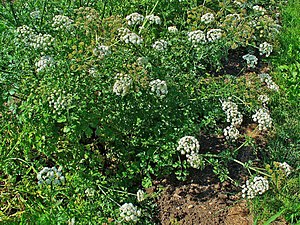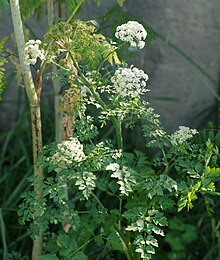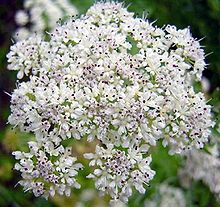Saffron vine umbels
| Saffron vine umbels | ||||||||||||
|---|---|---|---|---|---|---|---|---|---|---|---|---|

Saffron vine umbels ( Oenanthe crocata ) |
||||||||||||
| Systematics | ||||||||||||
|
||||||||||||
| Scientific name | ||||||||||||
| Oenanthe crocata | ||||||||||||
| L. |
The saffron vine umbel ( Oenanthe crocata ), also known as poisonous vine umbel , is a species of plant from the genus Oenanthe within the umbelliferae family (Apiaceae). The generic name Oenanthe is made up of the ancient Greek words οίνος oinos for “wine” and ἄνθος ánthos for “blossom” or “flower”, which can be traced back to the drowsiness reminiscent of drunkenness when poisoning begins; the specific epithet crocata means "saffron yellow" and refers to the sap that turns yellow in the air. Albrecht von Haller considered it “the true Herba Sardoa of the ancients” , with which the indigenous population of Sardinia is said to have killed the elderly and criminals - a view that a study group led by the chemist Giovanni Appendino also came to in 2009.
features
The saffron vine umbel is a biennial to perennial herbaceous plant that reaches a maximum height of 150 cm. The short, thick and curled " rhizome " is bulbous with up to 6 more or less thickened roots of fleshy to yellowish color. The sap is milky golden yellow. The entire plant is hairless. The branched stem is hollow, grooved and striped. It has two to four pinnate leaves with a furrowed stem.
The flowering period begins around June. The long-stalked inflorescence is a multi-rayed umbel . The 10 to 40 rays and the flower stalks do not widen until the fruit is ripe. The many five-fold flowers are white . The style is about half as long as the fruit. The cylindrical fruits are 4 to 6 mm long.
The number of chromosomes is 2n = 22.
Poisonous plant
Poisonous plant parts
The entire plant is toxic, but the rhizome is particularly toxic. The herb seems to contain less concentrated toxins. The sap clearly emerges from cuts. It has the property of then darkening. It contains polyethines , which are quickly destroyed in the air and are retained longer in the root meat. The polyethine content is highest in winter and early spring. It is noteworthy that, unlike closely related species, when consumed the plant neither tastes bitter nor causes a stinging sensation on the tongue, but on the contrary has a paradoxically sweet and pleasant taste and smell.
toxicology
The main active ingredient in late autumn is the poisonous polyethine oenanthotoxin with an LD 50 of 2.94 mg / kg body weight, injected intraperitoneally into a rat. In spring, the content of the ethyne compound oenanthetol is highest, along with traces of oenanthetone . Poisoning is associated with symptoms such as inflammation and blistering in the mouth, inflammatory disorders in the digestive system, circulatory problems, cramps that last for hours , bleeding , pupil dilation , trismus and bradycardia . A coma can also occur sometimes general insensibility. Amnesia may be present after returning consciousness from a coma . A 3-day remission phase is possible. In 10 documented cases, poisoning with the saffron vine umbel is said to have already resulted in death.
In grazing cattle, cramps were also detected after ingesting the saffron vines.
Medicine
With Matthiolus , the roots have a cough-relieving, stone-driving effect and prevent wetting. Others used Oenanthe crocata against stubborn skin rashes or in the beginning of epilepsy , especially with tic convulsif, speech paralysis and subsequent somnolence. The Homeopathy knows Oenanthe crocata in epilepsy, especially in connection with absence of rule, pregnancy, priapism or injury (such Cicuta ).
The plant is used in homeopathy , where it is used in the dilutions D 3 and D 4 . Under D 3 the concentration is ten times higher than under D 4 and symptoms of poisoning can occur. The homeopathic Oenanthe crocata is used for epilepsy , delirium , dizziness, ischemic stroke and for the follow-up treatment of meningitis .
Occurrence
The saffron vine umbel is common in southern France , the Iberian Peninsula and Morocco . It exists in different wetlands . Its distribution area includes Morocco, Spain, Portugal, France, Corsica, Sardinia, the Balearic Islands, Crete, Ireland, Great Britain, Belgium, Italy, Israel, Syria, Lebanon and Jordan. In the Netherlands the species is a neophyte.
literature
- Lutz Roth, Max Daunderer, Kurt Kormann: Poison Plants - Plant Poisons. 5th edition, Nikol, Hamburg 2008, ISBN 978-3-86820-009-6 .
- TG Tutin, VH Heywood, NA Burges, DM Moore, DH Valentine, SM Walters, DA Webb (Eds.): Flora Europaea . Volume 2: Rosaceae to Umbelliferae . Cambridge University Press, Cambridge 1968, ISBN 0-521-06662-X , pp. 339 (English, limited preview in Google Book search).
Individual evidence
- ↑ a b c Giovanni Appendino, Federica Pollastro, Luisella Verotta, Mauro Ballero, Adriana Romano, Paulina Wyrembek, Katarzyna Szczuraszek, Jerzy W. Mozrzymas, Orazio Taglialatela-Scafati: Polyacetylenes from Sardinian Oenanthe fistulosa : A Molecular Clue to risus sard . In: Journal of Natural Products . tape 72 , no. 5 , 2009, p. 962-965 , doi : 10.1021 / np8007717 , PMID 19245244 , PMC 2685611 (free full text) - (detailed in Sardonism ).
- ^ Heinrich Gottfried von Mattuschka : Flora Silesiaca, or directory of the plants growing wild in Silesia . First part. Leipzig 1776, p. 520 ( view in the google book search): "... although Herr von Haller is of the opinion that the Oenanthe crocata is the true Herba Sardoa of the ancients."
- ^ Professor of Organic Chemistry in the Pharmaceutical Faculty of the Università del Piemonte Orientale : Docenti - Dipartimento di Scienze del Farmaco → Giovanni Battista Appendino
- ↑ Oenanthe crocata at Tropicos.org. In: IPCN Chromosome Reports . Missouri Botanical Garden, St. Louis
- ^ Gerhard Madaus: Textbook of biological remedies. Volume III. Olms, Hildesheim / New York 1979, ISBN 3-487-05891-X , pp. 2006–2009 (reprint of the Leipzig 1938 edition).
- ↑ Peter Vint (ed.): The New Clarke. An encyclopedia for the homeopathic practitioner. Volume 3. Dr. Grohmann GmbH, Bielefeld 2001, ISBN 3-928953-13-3 , pp. 3853-3862 (after John Henry Clarke: Dictionary of Practical Materia Medica ).
- ↑ a b R. Hand (2011): Apiaceae. - In: Euro + Med Plantbase - the information resource for Euro-Mediterranean plant diversity. Data sheet Oenanthe

